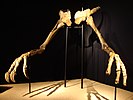Wikipedia:Today's featured article/July 9, 2016
The genus Deinocheirus (Greek for "horrible hand") was a dinosaur that lived during the Late Cretaceous around 70 million years ago. In 1965 its shoulder girdles and a pair of large arms (pictured) were first discovered in the Nemegt Formation of Mongolia, and in 2014 two complete specimens were described. Deinocheirus was the largest ornithomimosaur (ostrich dinosaur), at 11 m (36 ft) long, and weighed 6.36 t (14,000 lb), although it had many hollow bones. The arms were among the largest of any bipedal dinosaurs at 2.4 m (7.9 ft) long, with large, blunt claws on its three-fingered hands. The legs were relatively short, and bore blunt claws. Its vertebrae had tall spines that formed a sail along its back. The skull was 1.024 m (3.36 ft) long, with a wide bill and a deep lower jaw. Deinocheirus is thought to have been omnivorous; its skull shape indicates a diet of plants, and fish scales were found with one specimen. It probably used gastroliths to grind food. The large claws may have been used for digging and gathering plants. Bite marks on Deinocheirus bones have been attributed to the tyrannosaurid Tarbosaurus. (Full article...)

